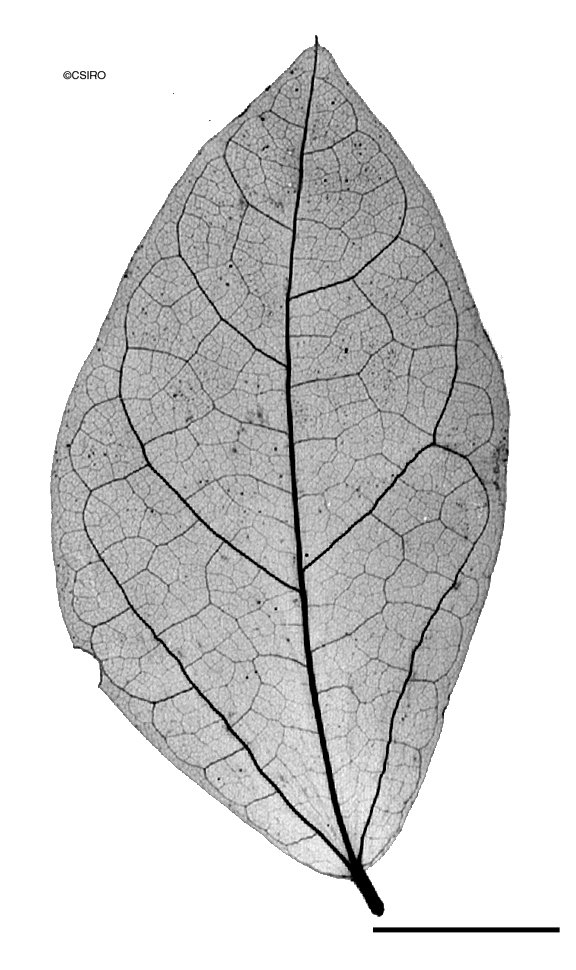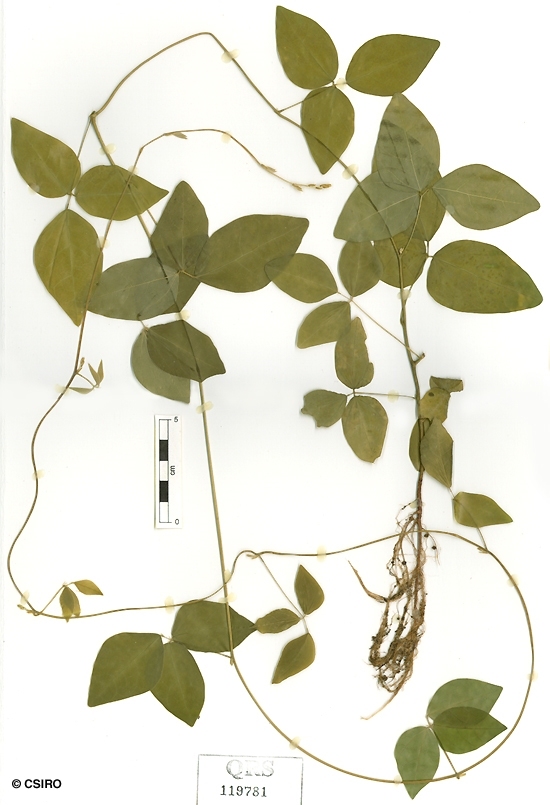Australian Tropical Rainforest Plants - Online edition
Macrotyloma axillare (E.Mey.) Verdc.





Verdcourt, B. (1970) Kew Bulletin 24(3): 402.
Perennial Horsegram
A slender vine not exceeding a stem diameter of 2 cm.
Leaflet blades about 2-6.5 x 2-4 cm, lateral leaflet stalks about 0.2-0.3 cm long, middle leaflet stalks about 10 mm long. Compound leaf petioles about 3.5-5 cm long. Both the upper and lower leaflet blade surfaces clothed in pale brown prostrate hairs. Stipules hairy, triangular, about 3-4 mm long. Stipels about 1-3 mm long. Twigs clothed in hairs.
Flowers borne in a compact raceme or panicle with flowers at different stages of development. Flowers about 9-11 mm diam., each flower subtended by two narrowly triangular hairy bracts about 2.5-3 mm long. Calyx tube about 2.5-3 mm long, lobes about 2-4 mm long. Petals: standard about 10-12 x 5 mm; wings about 9-14 x 2 mm; keel about 9 -15 x 12 mm. Stamens 10, the filaments of nine stamens fused to form a tube open on one side about 8 mm long with free filaments about 2-4 mm long at the apex. One stamen free. Anthers about 1 mm long. Pollen orange. Ovary hairy, about 7 mm long. Style about 4 mm long. Base of the ovary surrounded by a disk. Ovules about eight.
Fruits flat, about 40-50 x 7-10 mm, surface densely clothed with hairs, apex finely pointed with a point about 5-6 mm long. Seeds about 4-8 per fruit. Each seed about 2.54 x 3-3.5 mm, testa brown with black speckles. Cotyledons about 2.5-3.5 x 2 mm. Radicle straight or slightly curved, about 1.5 mm long.
Cotyledons caducous, about 4.5-5 x 2 mm. First leaves cordate, base auriculate to cordate, 3-veined at the base, midrib depressed on the upper surface. Leaf blades much paler on the underside. Pulvinus present, stipels absent. Third leaf trifoliolate. At the tenth leaf stage: stem twining, middle leaflet blade elliptic, lateral leaflet blades asymmetrical, smaller and usually ovate-elliptic, apex mucronate, base obtuse to cordate. Midrib hairy, raised in a groove on the upper surface of the leaflet blades. Both the upper and lower leaflet blade surfaces clothed in prostrate, translucent hairs. Stipules elliptic, longitudinally veined, hairy, about 4 mm long. Stipels present. Crushed roots emit an odour like that of green beans. Seed germination time 16 days.
An introduced species originally from Africa, now naturalised in NEQ and in south eastern Queensland and north-eastern New South Wales. Altitudinal range in NEQ from 750-1000 m. Usually grows in open forest or wet sclerophyll forest, sometimes on rain forest margins. Also naturalised in New Guinea.
Palatable to stock when they have become accustomed to it and tends to be more acceptable to stock late in the season. Meat of lambs grazing pure swards of this species may have an objectionable odour (Park and Minson (1972), J. Agric. Sci., Camb. 473-478). Hacker (1990).





